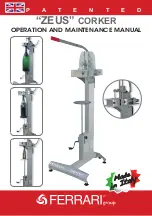
• Do NOT allow children near the stove while you are cooking.
• To avoid injury always use caution when handling hot
cookware.
• For safety reasons never leave cookware unattended while in
use and make sure the handles do not extend over the edge
of the stove. Do not allow handles to extend over a hot burner,
otherwise the handles might become hot.
• Lids and handles may become hot during prolonged cooking.
Use caution when removing lids or lifting with the handles.
Touch lightly to be sure the handles have not become hot.
Use oven mitts or pot holder if necessary.
• Always use oven mitts when removing pans from a hot oven.
• Always check lid temperature resistance before using in an
oven.
• Do NOT use in a microwave.
• Never use metal utensils on any non-stick surface. Plastic,
rubber or wooden utensils are recommended to prolong the
life of the pan.
• Do NOT hit your spatula or utensils on the edge, rim or
surface of your cookware.
• Do NOT cut food while it is in the pan.
Read all safety information carefully and thoroughly
before use!
Save These Instructions!
IMPORTANT SAFEGUARDS:
PRE-HEATING YOUR PAN ON THE STOVE TOP:
• For searing, sautéing and pan-frying pre-heat the pan using the
heat setting you intend to use when cooking before adding oil.
• Do NOT try to hurry the pre-heating process by using high heat.
• Do NOT allow the pan to boil dry.
COOKING WITH OILS & FATS:
• Some oils and fats burn at lower temperatures. Use oils and fats
that have a high smoke point, like refined olive oil, peanut oil, corn
oil and (clarified) butter.
Do not use extra virgin olive oil
as it
cannot withstand high heating and will leave a thin carbonized
layer on the non-stick surface.
• Because of the excellent heat conductivity of your pan and the
Te
TM
layer, food and oil carbonize very quickly. Always
cook on low to medium heat and only use high heat for searing or
browning.
•
Do not use any type of oil sprays, including aerosols, mist, and
pump sprays. These sprays cause residue build-up that is difficult
to remove from all types of cookware.
• Always distribute the oil evenly onto the surface of the pan.
• To determine if your pan is hot enough for sautéing, try the “butter
test”. Carefully wipe a dab of butter on the bottom of the pan. If it
bubbles briskly without burning, your pan is perfectly pre-heated.
RECOMMENDATIONS FOR BEST FOOD RELEASE:
• Always start with a clean pan. Wash carefully with a soft cloth and
be sure that you have removed all traces of cooking oil and food
before you store your cookware.
• Remove food from the refrigerators 10 minutes before you intend to
cook or fry.
• Remember to pre-heat your pan and allow the oil or butter to briefly
heat before adding food to the pan.
• If food slightly sticks to the pan during cooking, add a small amount
of water. Adding moisture will create a burst of steam that will
release any remaining food.
COOKWARE IS OVEN SAFE
GLASS LIDS ARE OVEN SAFE ONLY TO 420°F.
BEFORE FIRST USE:
• Remove all packaging materials and labels. Please recycle waste
properly.
• Wash in warm soapy water; rinse and dry thoroughly with a soft cloth.
• ALWAYS season pans before first use as follows:
1. Heat clean, dry pan on low heat for 30 seconds.
2. Remove from heat and add 1 tablespoon of vegetable oil.
3. Using a paper towel, rub the oil all over the entire INTERIOR
surface of the pan.
4. REPEAT each time you wash the cookware in a dishwasher.
RECOMMENDATIONS TO PREVENT THE
WARPING OF YOUR SIMPLY MING
TM
COOKWARE:
• Do NOT preheat your cookware on high heat.
• Never leave an empty pan on a hot burner. Doing so can
permanently damage your pan and stovetop.
• Do NOT allow the pan to boil dry.
• Do NOT put hot cookware under cold water. Allow the cookware to
cool completely.
• Do not drop the pan on the floor, and be careful not to warp or bend
the pan as this may deform the Te
TM
ceramic non-stick
coating, resulting in reduction of non-stick properties.
RECOMMENDATIONS FOR ENERGY-SAVING & BEST
COOKING AND FRYING RESULTS:
• Cook on a burner that is similar in base diameter to the pan you
have selected.
• When cooking on gas, adjust the flame so it does not flare up the
sides of the pan.
• Heat settings are very important. The Te
TM
coating
distributes heat more effectively, causing some protein-rich foods to
cook more quickly.
1. Use low heat to warm foods, simmer or prepare delicate sauces.
2. Use medium-high heat settings for searing, sautéing, frying and
stir-frying.
3. Use high heat for boiling and reducing liquids.






